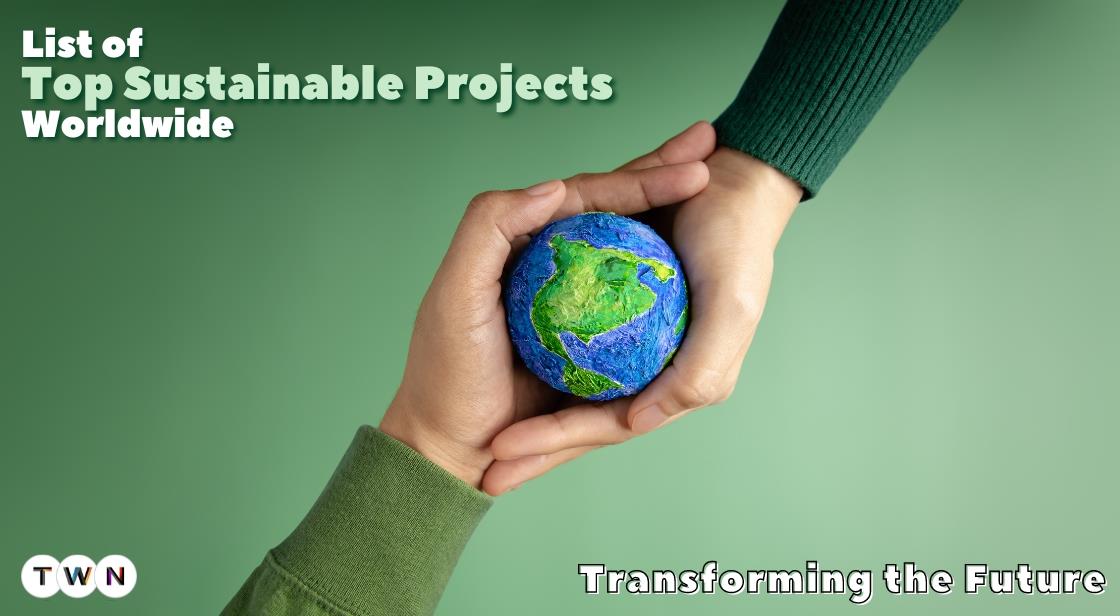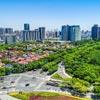List of Top Sustainable Projects Worldwide

Podcast
Post Highlight
In a world at a crossroads, where the impacts of climate change and environmental degradation loom large, the need for innovative and sustainable solutions has never been more pressing.
From every corner of the globe, a new breed of visionaries, forward-thinking organizations, and governments are taking bold steps to confront the challenges head-on.
These pioneers are not merely dreaming of a better future; they are actively shaping it. Their groundbreaking initiatives are contributing to a world where sustainability is not just an ideal but a living reality.
In this article, we embark on a journey to explore some of the most impactful sustainable projects worldwide.
From capturing greenhouse gases to create carbon-negative plastics, to the use of solar glass to revolutionize energy production and building aesthetics, these projects span a broad spectrum of innovation.
They're redefining the way we live, building a greener and cleaner planet for all.
As we delve into each project, you'll discover their remarkable achievements, the profound impact they've had on their surroundings, and their contribution to a more sustainable and eco-friendly world.
Popular Post
Continue Reading..
As climate change accelerates and environmental concerns intensify, the need for sustainable projects has never been more critical. Across the globe, visionary individuals, organizations, and governments are taking significant steps to address these challenges head-on.
They are pioneering groundbreaking initiatives that are making a real difference in creating a more sustainable future for all.
Let's embark on a journey to explore some of the most impactful sustainable projects worldwide. These initiatives cover a wide spectrum of efforts, from renewable energy to conservation, each contributing to the global goal of a greener, cleaner planet.
List of Top Sustainable Projects Worldwide: Transforming the Future
#AirCarbon
Country: United States
Company: Newlight
Person running the project: Mark Herrema, CEO and co-founder of Newlight
AirCarbon is a carbon-negative plastic developed by the company Newlight. It is made from captured greenhouse gases, such as methane and carbon dioxide, which are converted into tiny plastic pellets that can be formed into practically any shape.
Newlight's unique manufacturing process uses microorganisms to convert greenhouse gases into a biopolymer called PHB. PHB is a naturally occurring material that is found in plants and bacteria. It is biodegradable and can be recycled.
To make AirCarbon, Newlight first captures greenhouse gases from various sources, such as agricultural waste and industrial emissions. The greenhouse gases are then fed to microorganisms, which convert them into PHB. The PHB is then harvested and processed into plastic pellets.
AirCarbon can be used to make a variety of products, including food packaging, consumer goods, and industrial components. It is as strong and durable as traditional plastics, but it has a lower environmental impact.
Interesting facts about AirCarbon :
-
AirCarbon is the world's first carbon-negative plastic.
-
AirCarbon has been certified as carbon negative by SCS Global Services, a leading third-party certification body.
-
AirCarbon is made from 100% renewable resources.
-
AirCarbon is biodegradable and recyclable.
-
AirCarbon is being used by a variety of companies to make a variety of products, including food packaging, consumer goods, and industrial components.
AirCarbon is a promising new technology that has the potential to revolutionize the way we produce and use plastics. By converting greenhouse gases into plastic, AirCarbon can help to reduce our reliance on fossil fuels and mitigate climate change.
#Solar Glass
Country: United Arab Emirates
Company: Masdar City
Project: Masdar City solar glass roof
Solar glass is a type of building-integrated photovoltaic (BIPV) that can be used to replace conventional glass in roofs, skylights, facades, and windows. BIPV systems generate electricity while also providing the same aesthetic and functional benefits as traditional building materials.
Solar glass has a number of advantages over traditional solar panels. It is more aesthetically pleasing, as it can be seamlessly integrated into the building envelope. It is also more durable, as it can withstand the harsh environmental conditions that roofs and windows are exposed to. Additionally, solar glass can help to reduce energy costs and improve the energy efficiency of buildings.
The global solar glass market is expected to grow from $2.3 billion in 2022 to $10.4 billion by 2028.
This expansion is attributed to several key factors, such as:
-
The increasing demand for renewable energy
-
The increasing expenses associated with conventional electricity sources
-
The growing awareness of the environmental benefits of solar energy
-
The development of new and innovative solar glass technologies
Interesting facts about solar glass :
-
Solar glass is becoming more efficient. New solar glass technologies are being developed that can achieve higher conversion efficiencies than traditional solar panels. For example, the company Onyx Solar has developed a solar glass that can achieve a conversion efficiency of up to 22%.
-
Solar glass is becoming more affordable. The cost of solar glass has been declining in recent years, making it more affordable for homeowners and businesses to install. For example, the cost of solar glass has fallen by over 50% in the past five years.
-
Solar glass is being used in a wider range of applications. Solar glass is no longer just used for roofs and skylights. It is now also being used for facades and windows. For example, the company Solaria has developed a solar glass facade that can be used to generate electricity and reduce the cooling load of buildings.
Solar glass holds significant promise, poised to potentially transform the methods of energy generation and utilization. By replacing conventional building materials with solar glass, we can create buildings that are more energy-efficient, environmentally friendly, and beautiful.
Here are some examples of solar glass projects that are currently underway:
-
The Apollo House solar glass facade in Dublin, Ireland: This project uses solar glass to generate electricity and reduce the cooling load of the building.
-
The Masdar City solar glass roof in Abu Dhabi, United Arab Emirates: This project uses solar glass to generate electricity and provide shade for the surrounding streets.
-
The Heliotrope solar glass facade in Freiburg, Germany: This project uses solar glass to generate electricity and create a dynamic and ever-changing facade.
These projects demonstrate the potential of solar glass to transform the way we build and use buildings. As solar glass technology continues to develop and become more affordable, we can expect to see even more innovative and ambitious solar glass projects in the years to come.
Also Read : The Top Cleanest Cities in the World: Where to Live a Sustainable Lifestyle
#Cleaning the oceans with trash bins
Country: Australia
Company: The Seabin Project
The Seabin is also equipped with sensors that collect data on the state of the water, such as temperature, salinity, and pH levels. This data is transmitted to a cloud-based platform where it can be analyzed by scientists and policymakers.
The Seabin has been installed in over 100 ports and marinas around the world. It is estimated that the Seabin has collected over 1 million kilograms of trash since its inception.
In addition to collecting trash, the Seabin is also used to raise awareness and educate the public about ocean pollution. The Seabin Project, the non-profit organization that runs the Seabin program, offers educational programs to schools and community groups. They also organize beach cleanups and other events to raise awareness about ocean pollution.
The Seabin is a simple but effective solution to the problem of ocean pollution. It is helping to clean our oceans and make them a healthier place for marine life and humans alike.
Interesting facts about Seabin Project :
-
The Seabin is now being used in over 100 ports and marinas around the world.
-
It is estimated that the Seabin has collected over 1 million kilograms of trash since its inception.
-
The Seabin Project has launched a new initiative called Seabin Cares, which provides Seabins to underserved communities around the world.
-
The Seabin Project is also working on developing a new type of Seabin that can collect microplastics from the water.
#An All-Natural Alternative to Plastic Bottles
Country: France
Company: Lyspackaging
VeganBottle stands as a completely biodegradable bottle crafted from sugar cane, produced by the French packaging firm, Lyspackaging. It is a new alternative to environmentally-unfriendly one-use plastic bottles. VeganBottle is made from plant-based, fully biodegradable, and recyclable bioplastic.
VeganBottle is produced using a patented process that converts sugar cane into a bioplastic that is just as strong and durable as traditional plastic, but without the environmental impact. VeganBottle bottles are also free of BPA and other harmful chemicals.
VeganBottle is available in a variety of sizes and styles, including water bottles, sports bottles, and food containers. VeganBottle products are currently sold in France and other European countries, and the company plans to expand to other markets in the near future.
Benefits of VeganBottle:
-
VeganBottle bottles are 100% biodegradable and recyclable, so they do not contribute to plastic pollution.
-
VeganBottle bottles are made from plant-based materials, which reduces their environmental impact.
-
VeganBottle bottles are free of BPA and other harmful chemicals, making them safe for food and beverage use.
Interesting facts about VeganBottle bottles :
-
VeganBottle bottles are now available in over 1,000 stores in France.
-
VeganBottle has won several awards for its innovative and sustainable packaging solutions, including the Gold Medal for Innovation at the Emballage trade show in 2022.
-
VeganBottle is partnering with several major food and beverage companies to develop new products that use VeganBottle packaging.
#Zéphyr Solar
Country: France
Company: Zéphyr Solar
Zéphyr Solar is a French company that has developed a solar balloon that can be used to provide electricity in disaster relief and other humanitarian situations. The company was founded in 2017 by Cédric Tomissi and Julie Dautel.
The Zéphyr Solar balloon is a helium-filled balloon that carries a solar panel array. The balloon is tethered to the ground, and the electricity generated by the solar panel array is transmitted to the ground via a cable.
The Zéphyr Solar balloon has a number of advantages over other renewable energy technologies for use in humanitarian situations. It is easy to deploy and can be used in a variety of environments, including areas with limited infrastructure. The balloon is also relatively inexpensive and can be operated by unskilled personnel.
The Zéphyr Solar balloon has been used in a number of humanitarian situations, including:
-
In 2018, the balloon was used to provide electricity to a refugee camp in Chad.
-
In 2019, the balloon was used to provide electricity to a village in Madagascar that had been affected by a cyclone.
-
In 2020, the balloon was used to provide electricity to a hospital in the Democratic Republic of the Congo that had been affected by an Ebola outbreak.
Zéphyr Solar is also working to develop new applications for its technology. For example, the company is developing a solar balloon that can be used to provide power to electric vehicles.
Interesting facts about Zéphyr Solar :
-
Zéphyr Solar has recently raised €10 million in funding to scale up its operations.
-
The company is planning to deploy its solar balloons in 20 new countries in the next two years.
-
Zéphyr Solar is also developing a new type of solar balloon that can be used to provide power to electric vehicles.
#Improving access to water in Jamaica
-
Country: Jamaica
-
Companies: Sandals Foundation, The Coca-Cola Company
The Sandals Foundation and The Coca-Cola Company have partnered on a $50,000 project to improve sanitation and implement sustainable water harvesting systems in seven infant and primary schools in Jamaica. The project aims to provide more than 200 students with access to safe drinking water, clean toilets, and hand-washing facilities.
The project was launched in response to the COVID-19 pandemic, which has highlighted the importance of handwashing in preventing the spread of disease. However, many schools in Jamaica lack adequate water and sanitation facilities. This makes it difficult for students to maintain good hygiene and can lead to absenteeism and illness.
The Sandals Foundation and The Coca-Cola Company are working with local communities to install water tanks, rainwater harvesting systems, and handwashing stations at the seven schools. They are also providing training on hygiene and sanitation practices to students, teachers, and parents.
Interesting facts about project
-
The project is anticipated to reach its end by the conclusion of 2023.
-
In addition to improving water and sanitation facilities, the project is also expected to reduce the schools' reliance on external water supplies, which can be expensive and unreliable.
-
The project is part of the Sandals Foundation's ongoing commitment to education and the Coca-Cola Company's Water for Life program, which has provided access to clean water to more than 10 million people around the world.
Also Read : Four Positive Climate Change Developments
#TRUEGRID PERMEABLE PAVERS
Country: United States
Company: TRUEGRID
TRUEGRID permeable pavers are a sustainable alternative to traditional concrete and asphalt paving. They are made from recycled materials and allow stormwater to drain through them into the ground, reducing runoff and flooding. TRUEGRID pavers are also durable and require less maintenance than traditional paving.
Concrete and asphalt paving are major environmental concerns. They are made from non-renewable resources and require a lot of energy to produce. They also do not allow stormwater to drain through them, which can lead to flooding and pollution.
TRUEGRID permeable pavers can be used to build a variety of surfaces, including driveways, parking lots, and fire lanes. These are readily installable and applicable across various climatic conditions.
Here are some of the benefits of TRUEGRID permeable pavers:
-
Reduce stormwater runoff and flooding: TRUEGRID pavers allow stormwater to drain through them into the ground, which reduces runoff and flooding. This can contribute to safeguarding properties and infrastructure from potential harm.
-
Improve water quality: TRUEGRID pavers filter stormwater as it passes through them, removing pollutants such as oil, grease, and sediment. This helps to improve the quality of water in nearby lakes and streams.
-
Reduce the urban heat island effect: TRUEGRID pavers are lighter in color than traditional paving, which helps to reduce the urban heat island effect. This can make cities more comfortable and livable during hot weather.
-
Extend the life of roads and pavements: TRUEGRID pavers are durable and require less maintenance than traditional paving. This can help to extend the life of roads and pavements and save money on maintenance costs.
TRUEGRID permeable pavers are a sustainable and innovative solution for a variety of paving needs. They are becoming increasingly popular as cities and businesses look for ways to reduce their environmental impact.
Interesting facts about TRUEGRID pavers
-
The global permeable paving market is expected to grow from $2.3 billion in 2022 to $10.4 billion by 2028.
-
TRUEGRID pavers are made from 100% post-consumer recycled HDPE.
-
TRUEGRID pavers have a load capacity of up to 80,000 pounds per square inch.
-
TRUEGRID pavers are backed by a 10-year warranty.
#Vertical Farming for Urban Agriculture
Vertical farming is an agricultural method that encompasses the cultivation of plants in vertically layered systems. This allows for more crops to be grown in a smaller space, which is ideal for urban areas where land is scarce. Vertical farms also use less water and fertilizer than traditional farms, and they can produce crops year-round, regardless of the climate.
There are a number of different vertical farming technologies, but they all work in essentially the same way. Plants are grown in hydroponic or aeroponic systems, which means that they are grown without soil. In this method, the plant roots are suspended within a solution rich in nutrients.The solution is circulated through the system, and the plants absorb the nutrients they need.
Vertical farms can be located in a variety of different places, such as abandoned warehouses, shipping containers, and even skyscrapers. This makes them ideal for urban areas, where land is scarce and expensive.
Vertical farming offers several benefits in comparison to conventional agriculture.:
-
Conserves space: Vertical farms can produce more crops in a smaller space than traditional farms.
-
Reduces water and fertilizer use: Vertical farms use less water and fertilizer than traditional farms.
-
Produces crops year-round: Vertical farms can produce crops year-round, regardless of the climate.
-
Reduces pesticide use: Vertical farms are less susceptible to pests and diseases, so they require less pesticide use.
-
Reduces food miles: Vertical farms can be located in urban areas, which reduces the distance that food has to travel to reach consumers.
Vertical farming is still a relatively new technology, but it is growing rapidly. The global vertical farming market is expected to reach $16 billion by 2027.
Examples of vertical farming companies:
-
AeroFarms (US)
-
Plenty (US)
-
Gotham Greens (US)
-
Bowery Farming (US)
-
Vertical Harvest (US)
-
GrowUp Farms (Singapore)
-
Infinite Acres (US)
-
Agropolis (Germany)
-
LettUs Grow (UK)
-
Vertical Valley (Netherlands)
-
PlantLab (UK)
Latest and relevant facts about Vertical farming:
-
Vertical farming is becoming more affordable, as the cost of technology and equipment continues to decline.
-
Vertical farms are becoming more efficient, as new technologies are developed to improve crop yields and reduce water and fertilizer use.
-
Vertical farms are becoming more popular in urban areas, as cities look for ways to become more sustainable and food-secure.
#Solar Power in the Sahara Desert
The Sahara Desert is the world's largest desert, covering an area of over 9 million square kilometers. It is also one of the sunniest places on Earth, with an average of over 3,000 hours of sunshine per year. This makes the Sahara Desert an ideal location for solar power development.
There are a number of solar power projects underway in the Sahara Desert. One of the largest is the Noor Solar Power Complex in Morocco. The Noor complex is expected to generate over 2 gigawatts of electricity when it is fully completed in 2023.
Another major solar power project in the Sahara Desert is the Desertec project. The Desertec project is a proposed network of solar power plants that would generate enough electricity to power Europe and North Africa. The project is still in the planning stages, but it has the potential to be one of the largest solar power projects in the world.
Solar power development in the Sahara Desert has a number of benefits.
First, it can contribute to the reduction of greenhouse gas emissions and play a role in mitigating climate change.
Second, it can help to create jobs and boost economic development in the region.
Third, it can help to improve energy security and reduce the reliance on fossil fuels.
Latest and relevant facts about solar panels:
-
The cost of solar panels has fallen dramatically in recent years, making solar power development in the Sahara Desert more affordable.
-
New technologies are being developed to improve the efficiency and reliability of solar power plants in desert environments.
-
Governments in North Africa are increasingly supportive of solar power development.
Countries and companies involved in solar power development in the Sahara Desert:
-
Morocco: Noor Solar Power Complex, Ouarzazate Solar Power Complex
-
Algeria: Hassi R'Mel Solar Power Plant
-
Egypt: Benban Solar Park, Kom Ombo Solar Park
-
Tunisia: Tozeur Solar Power Plant, Gabès Solar Park
-
Mauritania: Nouadhibou Solar Power Plant, Boulenour Solar Power Plant
-
Desertec Industrial Initiative: a consortium of over 100 companies from Europe and North Africa
#The Greenbelt Movement, Kenya:
Country: Kenya
Organization: The Greenbelt Movement
The Greenbelt Movement is a Kenyan environmental organization founded in 1977 by Nobel Peace Prize laureate Wangari Maathai. The organization has planted over 51 million trees since its inception, helping to improve soil quality, reduce erosion, and provide an income for local communities.
Wangari Maathai, founder of the Greenbelt Movement
The Greenbelt Movement began as a response to the deforestation and soil erosion that was devastating Kenya's countryside. Maathai, who was a professor of forestry at the University of Nairobi, realized that trees were essential to the health of the environment and the well-being of the people. She began by planting trees in her own backyard, and then encouraged other women in her community to do the same.
Women planting trees in Kenya
The Greenbelt Movement quickly grew into a national movement. Women from all over Kenya came together to plant trees and protect the environment. The organization also began to advocate for environmental policies that would protect Kenya's forests.
The Greenbelt Movement's work has had a significant impact on Kenya. The trees that have been planted have helped to improve soil quality, reduce erosion, and provide a habitat for wildlife. The trees have also provided an income for local communities, who can sell the fruit and nuts from the trees.
The Greenbelt Movement has also been a powerful force for social change. The organization has helped to empower women and promote environmental awareness. The movement has also played a role in promoting democracy and human rights in Kenya.
Latest and relevant facts about Greenbelt Movement :
-
The Greenbelt Movement has planted over 51 million trees since its inception.
-
The organization has trained over 30,000 women in tree planting and nursery management.
-
The Greenbelt Movement has established over 2,000 tree nurseries across Kenya.
-
The organization has received numerous awards for its work, including the Nobel Peace Prize in 2004.
Conclusion:
These top sustainable projects showcase the power of human innovation and determination in the face of environmental challenges. While the road to a sustainable future is long, these initiatives inspire hope and action.
By harnessing renewable energy, conserving biodiversity, reimagining urban spaces, and deploying cutting-edge technology, these projects are contributing to a greener, more sustainable world.
As these endeavors continue to flourish, they demonstrate that we can collectively build a better, eco-conscious future for generations to come.








